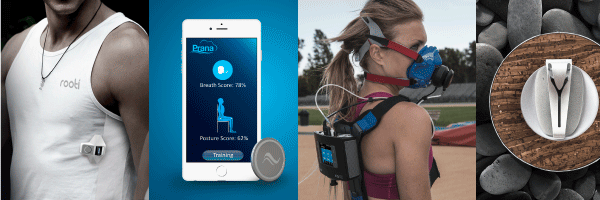If you thought that your breath can only help you to find out if you drank too much at a party you will be surprised about the variety of details our breath can reveal about our body. Latest breath and respiration analyzing technologies and devices can tell us how many calories we have burned during the workout, show which kind of food we can metabolize best, can help us to prevent burnout and detect diseases without invasive tests.
Breath analyzers for fitness and sports:
Cosmed’s K5 offers a very complete solution for professional athletes. The K5 can measure metabolic parameters like VO2, VCO2, Ventilation, HR, energy, expenditure and many more. The power suit includes an integrated camera-mount-screw-thread, a headphone for real-time communication, USB-device port for PC communication, real-time testing and data download. The system is a result of more than 25 years of experience in compact metabolic systems exploring human exercise physiology.

If you are willing to lose or maintain weight and live a healthier life, Breezing might be an option. The device can track your metabolism and helps you creating a personalized diet and exercise plan. All you have to do is – breathe. The app synchronizes wirelessly with your smartphone via Bluetooth and measures the speed of your metabolism. A higher number means a faster metabolism and that you burn more calories a day. The Respiratory Quotient tells you whether your body is burning carbohydrates, fats, or a mix of both. So you get a better impression about how eating habits affect your weight, mood and health.

Fabulyzer, which were also speaking at the 14th WT | Wearable Technologies Conference in Munich, are working on a handheld device which detects specific breath volatile organic compounds (particularly acetone) to provide an accurate indication of fat burning during physical activity. The device will also detect metabolism habits and will actively help you to optimize your exercise menu according to your fat-burn requirements.
A different approach is taken by BreathResearch. Their devices convert the air waves from breathing into sound waves which produce new respiratory analytics to improve health, fitness and performance. Their sensor-equipped BreathACoustics All-in-One Headset will be able to analyze the user’s breathing patterns, heart rate, pulse oximetry, altitude, location, baro metro pressure, metabolics to live a healthier life.
Wearables for breath training, breath optimization and relaxation:
Spire does not analyze the composition of your breath, but senses breathing patterns in real time to show when you are focused, tense, or frazzled. The tiny device can be clipped to your bra or waistband and monitors and cannot only track steps and encourages you to be more active but also detects if you are stressed and reminds you to take a rest to prevent burnout.
Another clip-on device is Prana. The device combines breath and posture tracking, based on recent medical studies and ancient Yoga traditions. The 3-axis accelerometer and algorithms measure the body’s breathing patterns. It differentiates between diaphragmatic and chest breathing which can give insights into the true quality of breathing – previously unaddressed by spirometers or pulse oximeters. Good breathing and posture can help to reduce stress, have a positive effect on the focus and less back pain.

Rooti Lab’s BioPatch is a biosensor continuously monitoring biometric data. Some ideas to use the device are telemonitoring solutions or taking care of your loved ones, e.g. you can send them a reminder to take a break when they are stressed.
Nozpad plans to use glasses for respiratory tracking for health and fitness indications. The glasses will have breath sensors fitted in the nose-pad . The information is shared with their servers and provides information about breathing rate and rhythm.
Breath Tech for medical diagnostics:
Analyzing the breath could be a non-invasive and potentially inexpensive way to detect illnesses such as cancer, multiple sclerosis, Parkinson’s disease, tuberculosis, diabetes and many more. Nanotech sensors with a very high sensibility can measure the amount and elevation of carbonyl levels or analyze volatile organic compounds in the human breath.
Alpha Szenszor’s CNTnose selectively differentiates between unique VOC patterns and offers solutions for oncology, asthma and COPD, substance abuse and several more areas.
San Francisco start-up Adamant Technologies has created a computer chip that can „take the sense of smell and taste and digitize them” (Sam Khamis, CEO) – means: your phone, computer or device can smell for itself. Possible applications are metabolic tracking, monitoring medical conditions like asthma or diabetes or test blood alcohol.
A quick and efficient way to diagnose diseases like diabetes or lung cancer is being developed by KAIST. Their device uses a highly-sensitive exhaled breath sensor which can be mounted on a smartphone. Made of tin dioxide nanofibers coated with catalytic platinum nanoparticles, the sensor can detect the presence of acetone (a diabetes signal) or toluene (a lung cancer signal) even at concentrations of less than 100 parts per billion.
There are several other studies as well on this topic, e.g. by the Georgia Institute of Technology and the Winship Cancer Institute of Emory University.
Breath and respiration can reveal a lot about the constitution – be it in the health, wellness or the sports context. The devices can help us to detect diseases at an early stage, maintain our weight and gives indication of a perfect diet by showing us how our individual metabolism works. They can assist us in optimizing our performance level and also inform us when it is time to take a rest to improve the well-being. Not all solutions may yet be convenient for your everyday life, but let’s see what kind of new form factors will come up in the future.













